Just recently, the news of the shortage of automotive chips has been brushed again, and the shortage of chips in global automotive factories has not been leveled off, and has risen again. Hexiaopeng, chairman of Xiaopeng automobile, used the reachable duck doll on his microblog to urgently ask for auto chips: most of the missing chips are proprietary chips, which are relatively cheap and receive little attention, but there is a shortage.
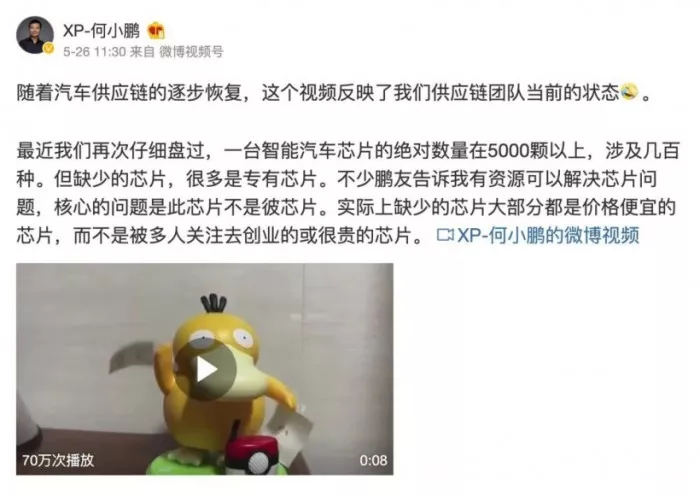
▲ hexiaopeng Weibo
The Melfi plant of stellantis group in Italy stopped production on June 2 and is expected to resume production on June 13. the shortage of chips is also the main reason for the shutdown .
According to the statistics of Research Institute autoforecast solutions, in the last week of May, automobile factories in North America planned to reduce production by 87500 vehicles, while automobile factories in Europe planned to reduce production by 4200 vehicles in one week.
So, after nearly two years of shortage of automotive chips, why is it still a difficult problem? Why hasn't the supply chain of automobile enterprises been solved**
The analysis shows that the reasons behind the shortage of chips are actually quite complex, but the general summary can be divided into three points:
- With the increasing consumption of smart car chips, the increased capacity of chip factories in the past two years has been offset.
- The impact of the epidemic has not yet ended, production and life at home and abroad have not yet fully returned to normal, and production and logistics will be difficult from time to time.
- Changes in the international situation have led to fluctuations in chip prices and supply, and the price and supply trends are changing every day, which is difficult to predict.
It is not difficult to understand why the whole industry has started to solve the two-year chip shortage. So far, the effect is still not obvious, and will continue.
Recently, chedongxi explored the supply of several major automotive chip suppliers, and obtained the current situation of automotive chip supply from chip agents, tier 1 and vehicle enterprises. According to these first-hand data, Che Dongxi summarized the changes in the industry during the recent two years of chip shortage, and found the reasons behind the chip shortage in 2022.
01. Different from the last time, some chips will have to wait six months
The time goes back to the middle of 2020 two years ago, when the COVID-19 epidemic was raging around the world. The automobile manufacturing industry and chip manufacturing industry were generally not optimistic about the future consumption prospects, and their inventories soared due to the inability to produce and the reluctance of consumers to consume.
In the second quarter of 2020, the internal inventory of Renesas electronics reached a very high level, with nearly 120 days of inventory and more than 50billion yen (about 2.585 billion yuan).
Similarly, Infineon, a major supplier of automotive chips, also had a similar situation. In its Q3 financial report of fiscal year 2020 (the second quarter of 2020), its inventory days reached 126 days, and the amount of inventory products reached 2.215 billion euros (about 15.895 billion yuan), which also increased significantly.
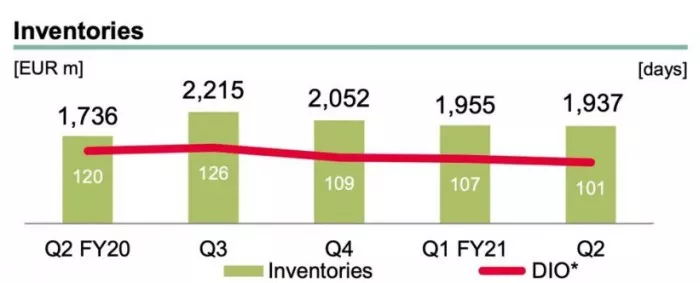
▲ inventory trend of Infineon from 2020 to the first quarter of 2021 (Note: Q2 in fiscal year 2020 means the first quarter of 2020)
In the second half of 2020, due to the sharp recovery of new car sales and the sharp increase in demand in the consumer electronics industry, the inventory of several major chip companies decreased significantly. Therefore, since the end of 2020, there has been a shortage of chips in the automotive industry, and Volkswagen, one of the world's largest auto companies, has stopped production in China.
Moreover, the declining trend of inventory days continued until the end of 2021. At that time, with the global spread of delta variant novel coronavirus and the impact of natural disasters, the second half of last year became the time when chips were most in short supply.
In the middle of 2021, there was a serious epidemic in Malaysia. The chip packaging and testing factories concentrated in Malaysia could not produce normally, resulting in a serious shortage of automotive chips, affecting a large number of vehicle enterprises. Some enterprises deliver "semi-finished products" to car owners, and some parts will be supplemented later.
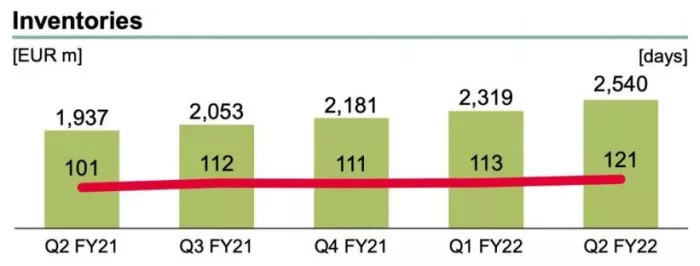
▲ Infineon inventory trend since 2021
According to the research of JPMorgan Chase, in the second half of 2021 alone, 2.6-3.6 million vehicles could not be produced due to the shortage of chips, and the annual production of vehicles was reduced by more than 10million .
After the whole automobile industry has seen the huge losses caused by the shortage of chips, it has already brought solutions. For chip enterprises, that is to expand production and gradually ease supply.
In fact, according to the financial data of several major automotive chip suppliers such as Renesas electronics, Italy France semiconductor and Infineon, by the first quarter of 2022, the number of days and amount of inventory have increased, which means that the chip supply is gradually getting better.
However, in the field of chip manufacturing, the problem of shortage has not been finally solved, and the problem of too long ordering cycle still exists.
Recently, Rutger wijburg, chief Production Officer of Infineon, said in an interview: "the capacity utilization rate of wafer factories is quite high. The 12-month delivery period is normal, and the 18 month or longer delivery period is becoming more and more common."
Therefore, Infineon has to outsource a new wafer factory every two or three years, and the frequency of outsourcing new factories has doubled.
According to the financial report of Renesas electronics, the utilization rate of its own 8-inch wafer production line has basically reached 100% since the beginning of 2021, that is, it operates at full capacity; Since the second quarter of 2020, the utilization rate of 6-inch and 8-inch production lines has also shown a rising trend, reaching 70% ~ 80%.
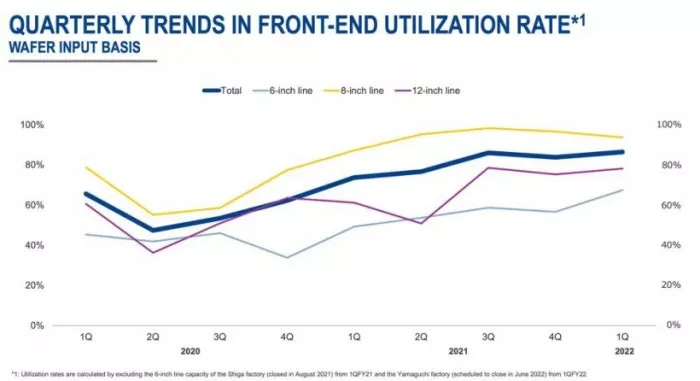
▲ utilization rate of Renesas electronic wafer production line
Moreover, the utilization rate of 6, 8 and 12 inch wafer production lines of Renesas electronics has exceeded the level before the epidemic in 2019.
Obviously, by 2022, the chip shortage will be very different from that in 2020.
According to the management personnel of many domestic and foreign chip dealers, the problem of chip shortage has not been fundamentally solved since this year. However, it can be found that the supply of chip factories with their own production lines is basically stable, the capacity of wafer foundry is still insufficient, or the delivery cycle is too long.
As a result, the supply of some automotive chips is relatively stable, but there are also chips that are out of stock in turn and the market situation changes day by day due to the "lack of understanding" among chip manufacturers, OEM, tier 1 and vehicle manufacturers.
Among them, the delivery cycle of some domestic vehicle specification level MCU is obviously very long, and some chips "take at least half a year" from reservation to delivery. One of the reasons behind this is the lack of production capacity. The relatively expensive SOC chips of Qualcomm, Broadcom and other enterprises are also in short supply.
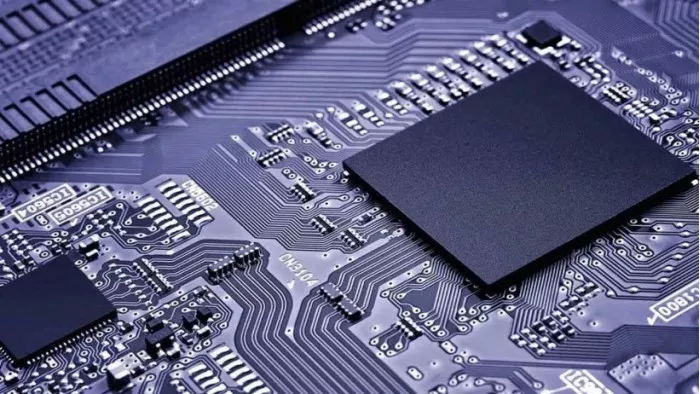
▲ MCU chip
In addition, there is another phenomenon in the market, that is, the supply of self-produced chip manufacturers is obviously relatively stable. If you find a factory for OEM production, the shipment will be relatively unstable. The source pointed out that Renesas electronics has its own wafer factory and can produce some products, so the shipment has been relatively stable since this year, while some chip enterprises in European and American countries are still in short supply.
It can be found that the shortage of chips in 2022 is obviously different from the shortage of chips in 2020 . In particular, the shortage of chips in turn gives dealers and suppliers a headache, because they don't know which one comes first in case of shortage or tomorrow.
02. Affected by the epidemic, the price of receiving and shipping chips has increased several times
From March to June this year, affected by the epidemic, production and living in Shanghai slowed down significantly, which is also the main reason for this round of chip shortage.
According to the introduction, during the epidemic period, the most difficult problem is logistics.
For example, Gaodao's warehouses are located in Shanghai and the Hong Kong Special Administrative Region. Since this year, all the products shipped from the Hong Kong Special Administrative Region have been normal, but Shanghai has been unable to ship. Finally, the basic shipment volume has been maintained by the insurance supplier.
Another leading chip dealer in China has a similar situation. The source said: "for example, some of our suppliers are located in Shanghai, so their chips cannot be shipped, and we cannot ship to Tier 1."
Finally, due to the poor logistics, the supply chain of the entire automotive chip was interrupted, and there was no goods available from the agent level. Tier 1 and the entire vehicle factory could only "stare" and wait for the agent to ship.
At the same time of shortage, the price fluctuation also follows. What is more annoying is that the chip is priced one day.
"There must be some price increases. We will adjust the price of the chip according to the market conditions. The market conditions change a lot, and the prices will be different every day." According to sources from domestic chip dealers.
According to the introduction, since this year, there has been a serious shortage of TPS series chips in Ti. This series of chips can be used for lighting, electric doors and other parts that need electricity in the car.
Among them, the chip with the most drastic price rise is the tps54618rter regulator chip of Texas Instruments. Since the end of last year, the price of this chip has been rising. Previously, its price was at the level of tens of yuan. After about half a year, its price has risen to hundreds of yuan, which is equivalent to several times.
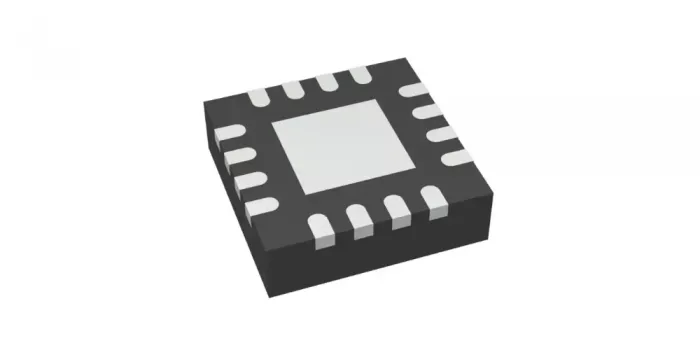
▲ Texas Instruments tps54618rter chip
The package size of this voltage regulator chip is only 3mm*3mm, which is like a drop in the bucket when installed in the car. However, this chip can stabilize the output voltage and current to ensure the safe and stable operation of electronic components in the vehicle. For cars, this small chip is indispensable.
A source from Gao Dao also pointed out that the prices of some chips have risen this year.
*In fact, the rise in chip prices has already affected vehicle enterprises *. Shen Hui, CEO of Weima automobile, recently posted a microblog saying that the price increase involved a number of Tier1 enterprises, and the price increases were all essential chip components.
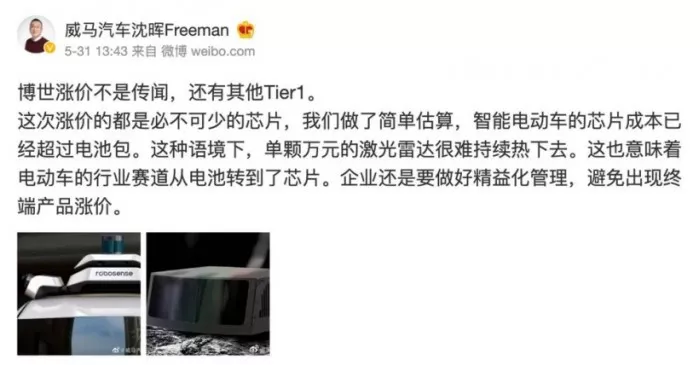
▲ Weibo of Shenhui, CEO of Weima automobile
He also stressed that the cost of electric vehicles will not only be affected by the rise in the price of battery raw materials, but also by the rise in the price of chips. Therefore, car enterprises need to make careful calculations to control the cost price of vehicles.
In May this year, the old process products of STMicroelectronics and Adi announced price increases, which almost reproduced the chip shortage + price rise tide in 2021.
It is understood that one of the main reasons for the rise in chip prices this year is the sharp rise in raw material prices.
Since this year, conflicts between Russia and Ukraine have affected the chip industry to a certain extent.
In the process of chip manufacturing, the inert gas neon is the key raw material. According to the data of market research company techcet, about 48% ~ 54% of the world's neon gas is supplied by Ukraine's inGas and cryoin companies. In addition, 540 tons of neon gas are used for chip manufacturing in the world every year. In March this year, due to the military conflict between Russia and Ukraine, two major neon companies in Ukraine stopped production.
At that time, neon prices from other countries had already begun to rise.
In fact, the prices of other raw materials are also rising, not just neon. After two months, it affected the shipping price of the chip.
As Shenhui, CEO of Weima automobile, said, the price of automobile chips has surpassed that of batteries, so the price rise of chips may even drive the price rise of electric vehicles again in the second half of the year.
Obviously, the chip shortage tide in 2022 is not only mixed with direct reasons such as insufficient production capacity and too late ordering, but also objective reasons such as poor logistics during the epidemic and changes in the international situation. These reasons are even more uncontrollable, making it more difficult to solve the problem of chip shortage.
03. More shortage of smart car chips will continue
From the above analysis, we can see that since the second half of 2020, the situation of chip shortage has changed, and the supply of chip enterprises has gradually improved. However, there is another reason that has been ignored by more people. That is the rapid rise of intelligent electric vehicles since 2020, and more chips are used.
Hexiaopeng, chairman of Xiaopeng automobile, said on his microblog that the number of chips in a smart car should be more than 5000, and there are hundreds of types .
Tan Minqiang, deputy chief engineer of Dongfeng Motor Group Co., Ltd., pointed out: "The number of chips in traditional fuel vehicles is about 500 to 600. With the increase of automatic driving, new energy and other functions, the number of chips in high-end vehicles is about 1000 to 1200. According to statistics, automotive chips can be roughly divided into seven categories: computing chips, control chips, power chips, sensing chips, drive chips, storage chips and power chips. There are many types and many sub models."
Therefore, compared with the era of traditional fuel vehicles, the demand for chips in intelligent electric vehicles has increased several times, and not many SOC chips have increased, but more chips are "proprietary but very cheap" chips as hexiaopeng said.
At the same time, the penetration rate of intelligent electric vehicles is growing rapidly. According to the new car insurance volume data, in April, the fuel car insurance volume decreased by 49.7% year-on-year, the new energy increased by 57.7% year-on-year, and the penetration rate reached 26%. That is, one of every four new cars is a new energy vehicle.
*Compared with 2020, the penetration rate of domestic new energy vehicles is actually only 5.8%, which is only a scale of more than one million vehicles. However, by 2021, the penetration rate of new energy vehicles has reached 14.8%, that is, 3521000 *.
For the whole automobile market, there are more and more new energy vehicles, which means that the growth of chip demand is faster than that in previous years.
Therefore, after 2020, when the production capacity is insufficient, although the chip manufacturers are expanding their production capacity, they can not meet the rapid growth trend of intelligent electric vehicles, and even the expanded production capacity has long been offset by the rapid growth of electric vehicles.
From the inventory situation of several major chip enterprises, the inventory situation is still lower than the level at the end of 2019, the number of inventory days has not reached the expectation, and the amount of inventory products is relatively low. This means that although the problem of chip shortage has been alleviated, it is far from being completely solved.
In fact, as early as the beginning of this year, it was predicted that the sales of new energy vehicles in 2022 would exceed 5million. At the same time, coupled with the upgrading of the electronic and electrical architecture of fuel vehicles, chips have long been key components of intelligent vehicles.
The burden of solving the shortage of automotive chips has once again weighed on chip manufacturers.
04. Conclusion: the structural shortage of chips is still prominent
Since the second half of 2020, the shortage of chips has become a structural problem, which is quite difficult to solve.
As early as last year, Bosch CEO Volkmar Denner said that the impact of chip shortage has ended, but the structural shortage still exists. That is, the objective reasons mentioned above are difficult to predict, but the impact is huge.
At first, the automobile and chip industry predicted that the chip supply would be eased in 2021. The normal supply in 2022 has now become the normal supply in 2022. The normal supply in 2023 has been delayed for a whole year.
It can be predicted that in the second half of 2022, the penetration rate of electric vehicles, intelligent cockpit and automatic driving configuration will continue to rise, and the demand for chips in the automotive industry will also continue to rise.